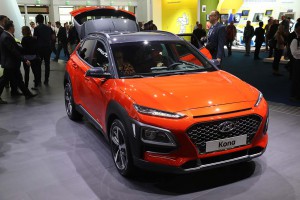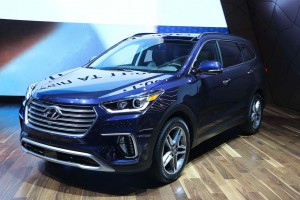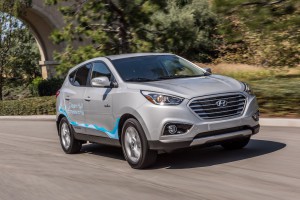Struggling to adapt to rapid changes in the U.S. new vehicle market, Hyundai plans to introduce eight all-new or significantly updated crossover-utility vehicles by 2020, the automaker revealed during a media briefing on Wednesday morning.
The wave of new models will range from a sub-compact, or A-segment ute up to a three-row, eight-passenger offering. The Hyundai Kona, set to be unveiled at the upcoming Los Angeles Motor Show, will become the first of the new products to go on sale.
“CUVs are what’s really driving growth in the U.S. market,” said Mike O’Brien, Hyundai Motor America’s vice president of corporate planning, and the lack of a full range of utility vehicles is a key reason why analysts say Hyundai has lost momentum over the last several years after a decade of rapid growth.
Light trucks, in general, have surged since mid-decade and currently account for almost two-thirds of U.S. new vehicle sales. That includes pickups and Hyundai earlier this year confirmed it will enter that segment, albeit on a modest scale, with a production version of the well-received Santa Cruz concept that debuted at the 2015 North American International Auto Show.
(Hyundai may build Santa Cruz, new SUVs in U.S. market. Click Here for that story.)
But its real push will be into the broader utility vehicle market. There are no plans to offer traditional, truck-based utes, Hyundai sticking with car-based crossovers like its current Santa Fe and Tucson models.
The 2018 Kona begins the assault. It is a B-segment, or subcompact model, a class-size smaller than the current Hyundai Tucson, and will go up against such competitors as the Honda HR-V.
In something of a surprise, Hyundai officials revealed they also will target the A-segment with another upcoming CUV, a pioneering move for the U.S. market, though such models have already become quite popular in Europe and parts of Asia.
(Click Here for more on the Hyundai Kona.)
At the other extreme, O’Brien confirmed plans for a three-row, eight-passenger crossover. Hyundai already has a midsize vehicle, the Santa Fe, but it competes in the lower-priced and smaller portion of the segment. It would be “on target,” the executive suggested, to think of the new model as being sized closer to the current Ford Explorer.
Both the A-segment and midsize models are due out in 2019 as 2020 model-year offerings. Several other new crossovers are expected to reach market before then, though Hyundai isn’t ready to discuss them yet. Asked if the Korean carmaker might be readying a challenge to larger competitors like the Chevrolet Tahoe, O’Brien suggested “you might speculate,” while cautiously refusing to confirm specific plans.
Hyundai officials said Wednesday that their new CUV family will include products using a mix of drivetrain technologies, and O’Brien confirmed that will include diesel, pure battery-electric and hydrogen variants. The current Tucson Fuel Cell Vehicle is widely expected to be replaced by a dedicated CUV model. The company Wednesday confirmed that it will be unveiled at the Consumer Electronics Show in Las Vegas in January, though it would not discuss specific details like range or cost.
Getting more utility vehicles into the market will be critical for Hyundai to rebuild momentum, acknowledged O’Brien, in a conversation with TheDetroitBureau.com. Right now, CUVs account for only about a third of the maker’s U.S. volume, though demand for its existing models has been surging – sales of the Tucson, for example, up 25% for the first 10 months of 2017.
When the new models are available, he added, “We want to meet the industry which is over 50%” utility vehicle sales.
For her part, analyst Stephanie Brinley, of IHS Automotive, said the company’s crossover strategy is essential.
“This what consumers want,” said Brinley. “The basic trend to utility vehicles has been obvious for about 20 years and it is only to continue to accelerate.”
(Industry pushing for bigger investment in hydrogen power. Click Here for more.)



